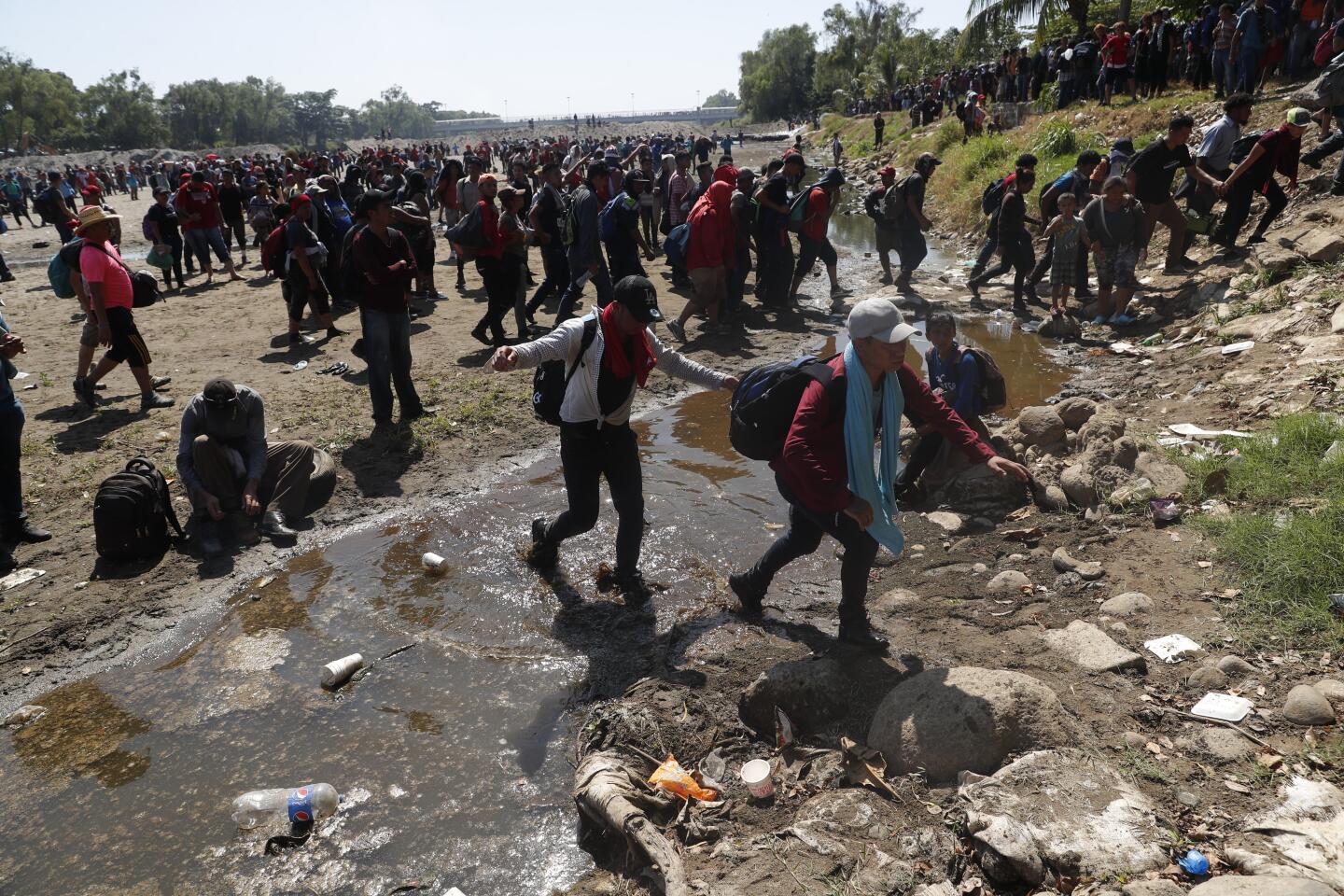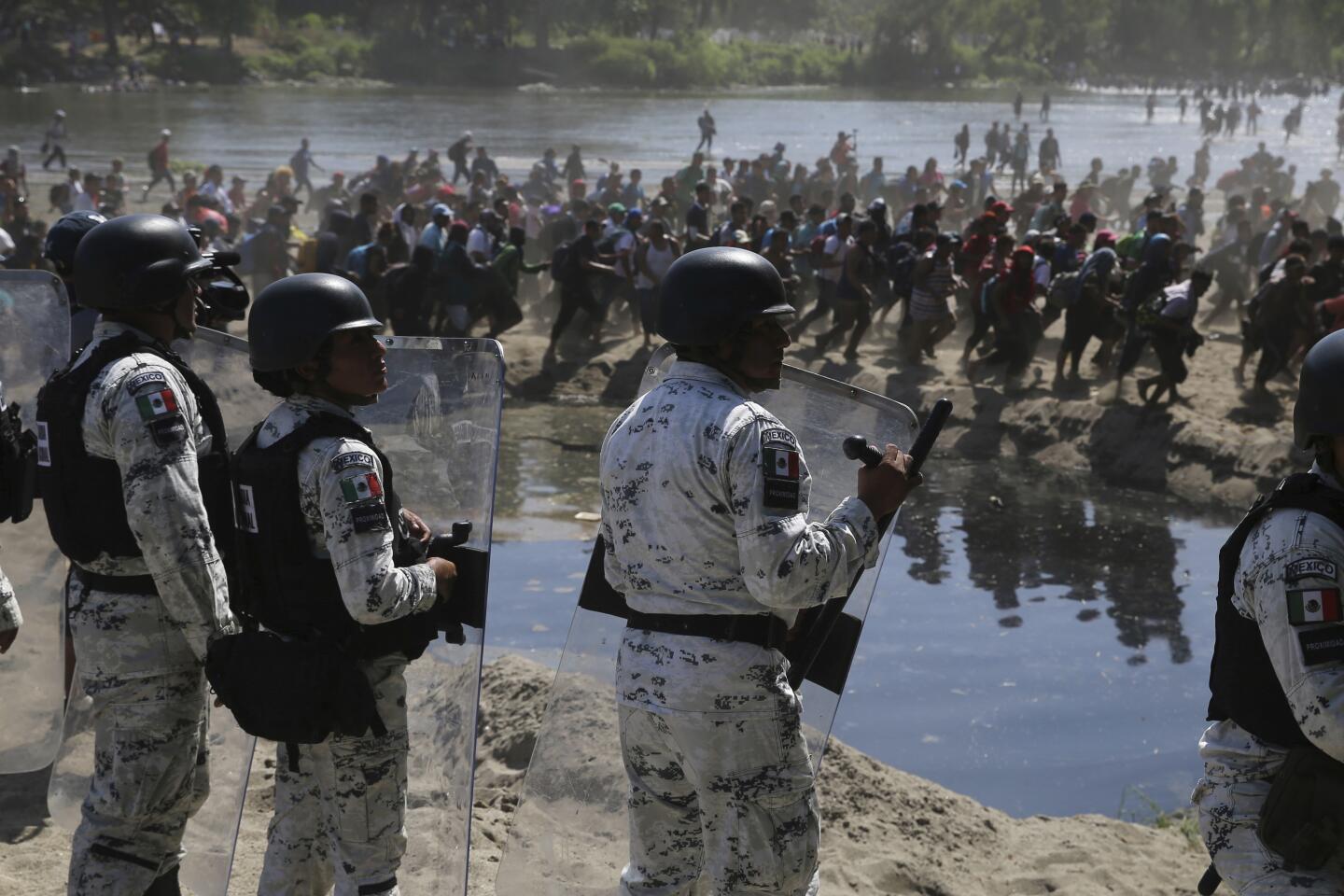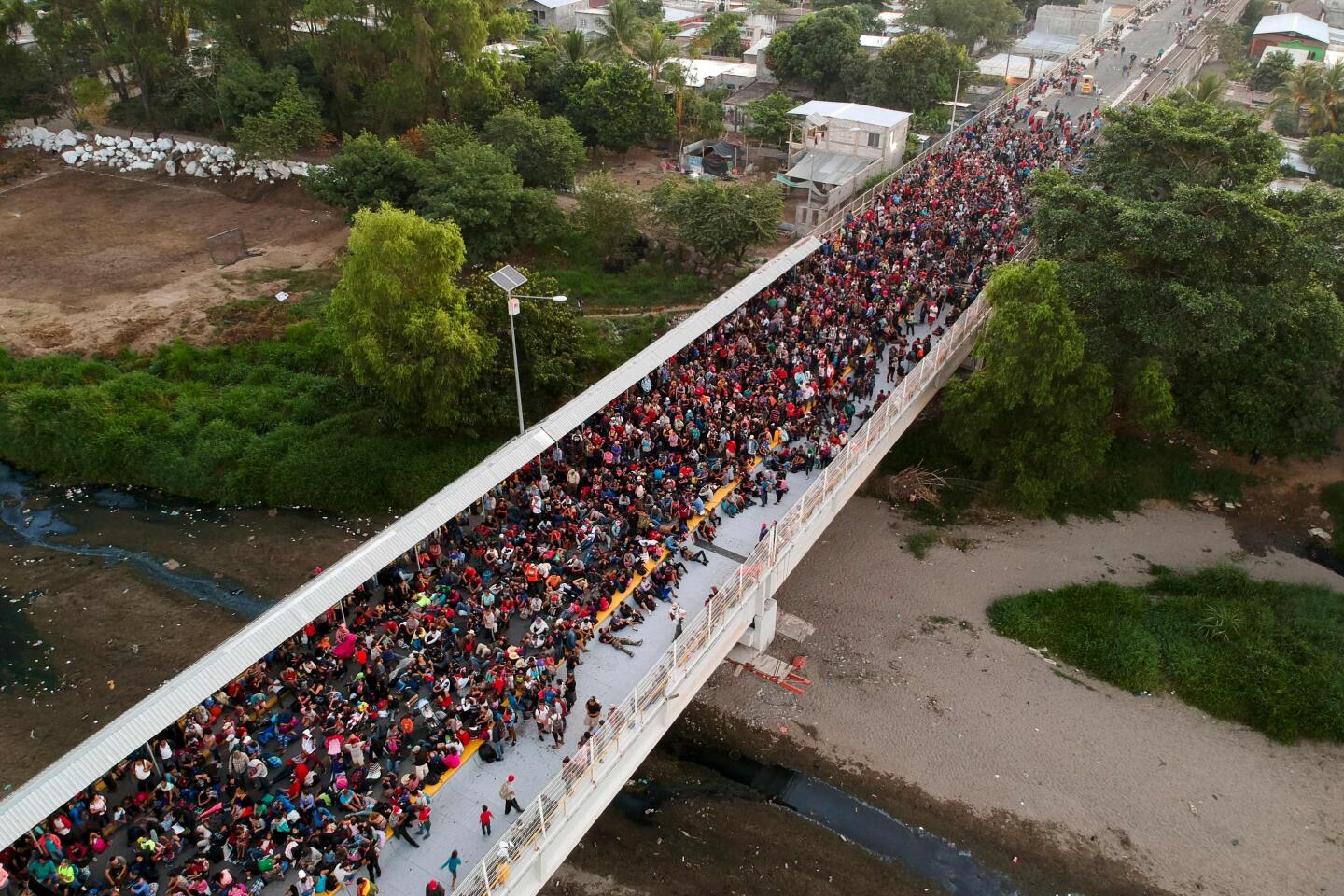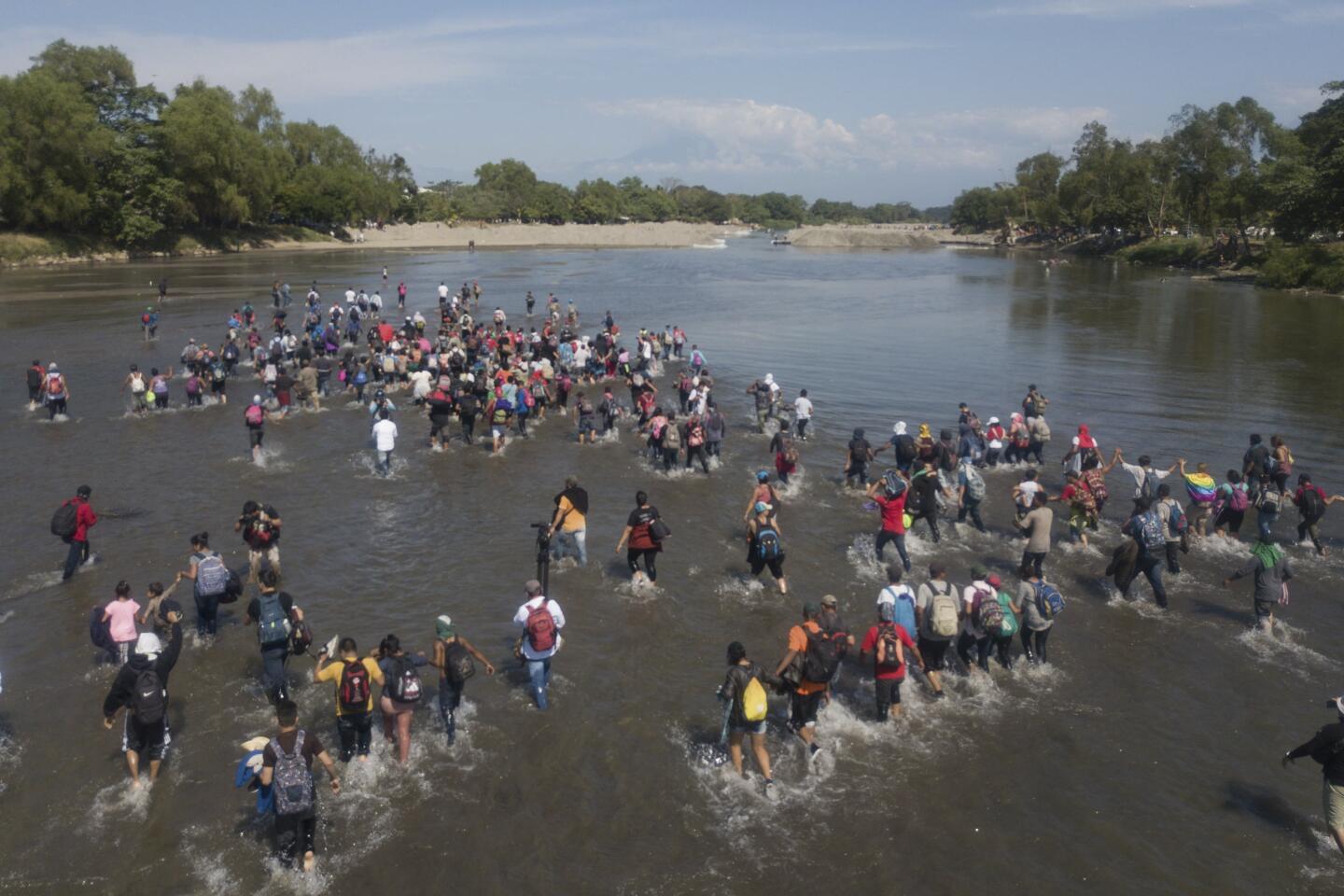Migrants scuffle with Mexican troops along border river
- Share via
CIUDAD HIDALGO, Mexico — Hundreds of Central American migrants waded across the Suchiate River into southern Mexico on Monday in a new test of President Trump’s Central America strategy to keep them away from the U.S. border.
Some scuffled with national guardsmen on the riverbank while others slipped through Mexican lines and trudged off on a rural highway in small groups. Immigration authorities nabbed more there and chased others into the brush.
Most, however, remained at the river’s edge or stood in its muddy waters trying to decide what to do next, after being blocked from crossing en masse over the border bridge leading to Ciudad Hidalgo.
“Mexico’s president said he would give us work and an opportunity and look,” said Esther Madrid, a Honduran vendor who left her six children in Honduras. Sitting on a rock among dozens of people who didn’t know what to do next, she offered only one word when asked if she would consider returning to San Pedro Sula: “Never.”
Mexico’s strategy, developed after the first migrant caravan in late 2018, to repeatedly break up the mass of people and into increasingly smaller groups appeared to be working. Over the weekend, government officials convinced about 1,000 people they should enter legally over the border bridge.
On Monday, migrants were detained at the river and along the highway. Those who continued could expect a gauntlet of highway checkpoints while trying to move north.
After the river crossing Monday, Mexico’s National Immigration Institute issued a statement saying that it would detain any migrants without legal status, hold them in detention centers and deport those who did not legalize their status.
As feared, children suffered most in the clashes. On the Mexican riverbank an unconscious 14-year-old girl was carried away for medical attention. A guardsman said she had started convulsing in the commotion.
Later along the highway, a mother sobbed after realizing her youngest daughter had been separated when migrants tried to escape authorities. Sauri Marubeny Ortega had been walking with her four daughters, ages 5 to 16. Another migrant who had been helping her by carrying the 5-year-old ran in another direction when the migrants scattered and she hadn’t been able to locate them.
“When the federales’ cars began arriving, he ran off that way and I took off after him,” she said. But when she saw an agent nab another daughter she didn’t know who to help and lost sight of the youngest.
“I just beg the person who has her to leave her in a safe place and tell the police,” the mother said as members of Mexico’s migrant assistance force, Grupo Beta, loaded her and three of her girls into an ambulance. “I don’t want to leave here without my daughter.”
The migrants started the day on the bridge connecting Guatemala and Mexico, where they read aloud a letter asking Mexico President Andrés Manuel López Obrador for permission to cross Mexico en route to the U.S. border.
Mexican officials replied that free passage not be offered. They urged the migrants to enter legally, registering at the bridge and seeking protection and work permits if they wished to remain in Mexico. It was an offer many migrants viewed with suspicion.
That sent the migrants down to the Suchiate where hundreds forded its shallow waters and soon faced guardsmen.
On the Mexican side, migrants ran from side to side along the river bank, kicking up dust and looking for an opening in the ranks of National Guard troops sent to meet them.
Guardsmen scrambled, too, trying to head off groups and detaining people where they could. There was pushing and shoving. Some guardsmen carried plastic riot shields that were hit by rocks thrown by migrants, and they occasionally zipped a rock back into the crowd. Others jogged to get into position with long staffs. Still others carried assault rifles.
Many of migrants moved back to the river’s edge and a smaller number crossed back to Guatemala.
“You have two options: You go back to Guatemalan territory or you come with us,” Mexican immigration agents said to migrants who crossed the river. They assured those who went with them that they would “regularize” their status, but few of the migrants believed them.
Riot police with shields also appeared on the Guatemala side of river, raising questions about what options remained for the migrants.
While Mexico’s government says the migrants are free to enter — and could compete for jobs if they want to stay and work — in practice, it has restricted such migrants to the southernmost states while their cases are processed by a sluggish bureaucracy. Those who do not request asylum or some protective status would likely be detained and deported.
Trump has forced asylum seekers to remain in Mexico, or apply for protection in Central American countries, effectively removing one of the escape valves for previous caravans. Under threats of trade or other sanctions from the Trump administration, Mexico has stopped an earlier practice of allowing migrants to cross its territory unimpeded.
The Guatemalan government issued new data Monday showing that 4,000 migrants crossed into that country through the two primary crossings used by the migrants last week, and over the weekend nearly 1,700 entered Mexico at two crossings. It said 400 had been deported from Guatemala.
After two caravans successfully reached the U.S. border in 2018 and early 2019, Mexico began cracking down, and by April 2019 raided the last attempt at a caravan, rounding up migrants as they walked down a highway.
As this week’s caravan approached, Mexico sent soldiers to patrol its southern border and monitored the area with drones. Migrants sometimes travel via caravan because it provides safety in numbers and offers a chance for migrants too poor to pay smugglers.
Amid the chaos of the crossing some found a warmer reception.
“We went into a house and the very kind woman told us to stay there, that they (authorities) had no right to enter and she gave us food,” said Bryan Fernández of Honduras. He said he didn’t know what to do now though. “If it gets ugly, we don’t know which way to go.”
More to Read
Sign up for Essential California
The most important California stories and recommendations in your inbox every morning.
You may occasionally receive promotional content from the Los Angeles Times.






















